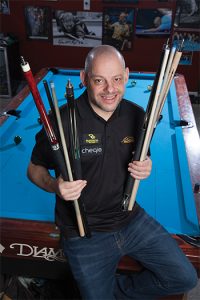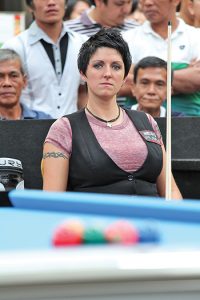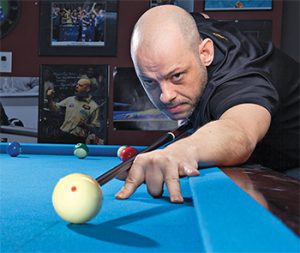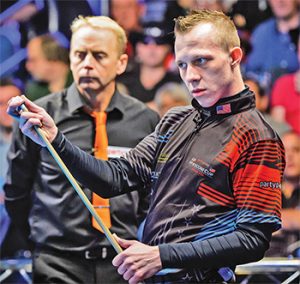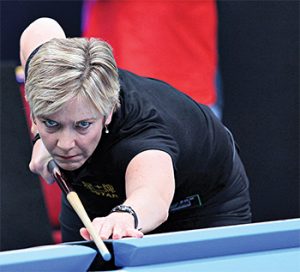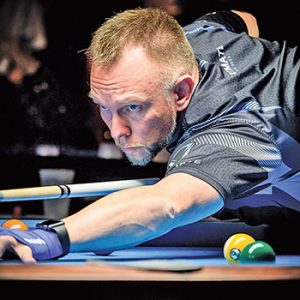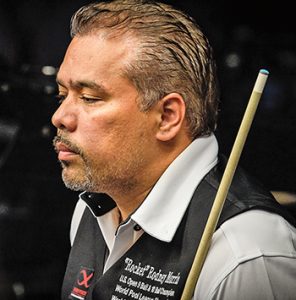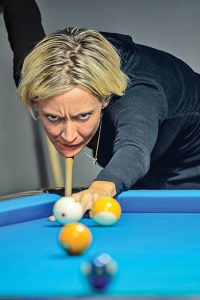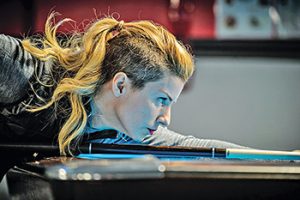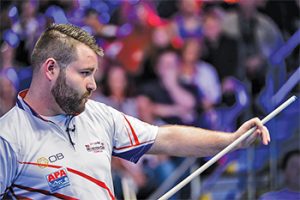KELLY FISHER HOF
Kelly Fisher, already the winner of two world titles and dozens of professional events, thought that overcoming heart surgery and a double mastectomy to win her third world crown in 2019 was the most significant achievement of her storied pool career.
That all changed July 13 when the 41-year-old British native learned that she had been elected into the Billiard Congress of America Hall of Fame.
“It’s hard to explain what I’m feeling right now,” Fisher said from her home in Dumfries, Scotland, after receiving news of her election. “It’s different. It’s not a competition. It’s a reward for all you have accomplished. You win Player of the Year and that’s great. Then you win Player of the Decade and that’s even more rewarding. But to be voted into the Hall of Fame, that is another level completely.”
Fisher was the sole inductee into the 2020 BCA Hall of Fame, garnering votes on 70 percent of the Hall of Fame Board ballots to gain election from a list of eligible players that included first-timers Dennis Orcollo of the Philippines and Thorsten Hohmann of Germany, as well as American Corey Deuel, Dutchman Niels Feijen and six other candidates.
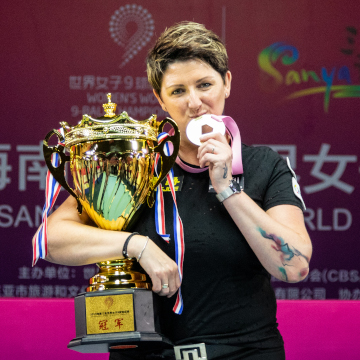
“I remember coming to the U.S. in 2004 and seeing players get into the Hall of Fame over the next few years,” said Fisher. “They’d been playing for many years and won so many titles. I wondered whether I could get to that level. As I got older, the thought of getting into the Hall of Fame became a realistic goal, which would mean the world to me.”
Fisher arrived in the U.S. in 2004 to join the Women’s Professional Billiard Association Classic Tour after having earned six snooker Women’s World Championships over a six-year period from 1997 to 2003. She broke into the WPBA’s Top 10 in less than a year and won her first WPBA title in 2005. She went on to win eight WPBA titles from 2006 to 2010. She reached the WPBA No. 1 ranking in 2008. Fisher captured her first World Pool-Billiard Association (WPA) world title in 2011, when she won the World 10-Ball Championship. A year later, Fisher claimed the World 9-Ball Championship. She also earned four International Tournament of Champions titles, winning in 2009, 2010, 2013 and 2014.
Fisher moved back to England in 2013. In 2014, she underwent surgery to repair a hole in her heart and, a year later, underwent a double mastectomy. She recovered to win professional titles in each of the following three years, before completing her comeback with her second World 9-Ball Championship in late 2019.
“Winning the World 9-Ball Championship last year meant so much to me,” she admitted. “It came out of the blue. I knew I was still capable, but I was over 40 and the quality of play is so high. I remember being very nervous before the final and that surprised me. I had been in many finals, but at that stage you just don’t know how many more chances you’re going to have.” Fisher was named Billiards Digest Player of the Decade for the 2010s.
In her first year of eligibility for the BCA Hall of Fame in 2019, Fisher was edged out by Canadian Alex Pagulayan in a special run-off ballot after the two had tied as top vote getters in the initial election. Both Orcollo and Hohman tallied 23 votes (51 percent) in the 2020 election. Deuel and Feijen were each named on more than 20 percent of the ballots. Shannon Daulton, Jeremy Jones, Stefano Pellinga, John Schmidt, Vivian Villarreal and Charlie Williams completed the 2020 ballot.
Voting for the 2020 BCA Hall of Fame was conducted by the USBMA Hall of Fame Board, which consists of USBMA members, elected At-Large members and living members of the Hall of Fame. To be eligible for consideration in the Greatest Players category, a player a) must be 40 years old by Jan. 1 of the year of their inclusion on the ballot; b) must have a professional playing career of at least 10 years; and c) must have recorded significant achievements in U.S.-based and international events recognized by the BCA.
Fisher ‘Great’ Following Heart Surgery
“Everything went really well,” said a fatigued but upbeat Kelly Fisher, from her hospital bed in the Intensive Care Unit at Golden Jubilee National Hospital near Glasgow, in the United Kingdom. “The doctors were over the moon. They said it couldn’t have gone better.”
Fisher, ranked second in the world by the World Pool-Billiard Association and the sixth-ranked player on the Women’s Professional Billiards Association tour, underwent surgery on July 22 to repair an atrial septal defect, also known as a “hole in the heart.” While a congenital defect, the 35-year-old Fisher had not experienced any severe problems until recently.
“I’d been bothered with a palpitation for many years,” Fisher said a week prior to the surgery, “but was told in 2009 that it was just a heart murmur, and that I had nothing to worry about.”
Fisher said she noticed that the palpitations were becoming more frequent in the past year, so she scheduled a doctor’s appointment in early March, following the Amway Cup in Taiwan (where Fisher finished second to Yu-Chieh Chou). Following tests at her local hospital in Dumfries, Scotland, Fisher was referred to Golden Jubilee in Dunbartonshire. An MRI and further tests discovered the congenital defect, which showed damage to a valve and a dilation of the right side of her heart.
“I was very lucky that it was found now,” Fisher said, “before it caused any permanent damage to my heart.”
A full recovery is expected to take three months, but Fisher said she hopes to shave a few weeks of the recovery time to participate in the Women’s World 9-Ball Championship in Guilin, China in mid-October.
“The doctors and staff were fantastic in my preparation for the operation,” said Fisher, who was expected to be out of ICU less than 48 hours after surgery. “I was off the ventilator very quickly. With plenty of rest and physio, recovery should be good. My goal is to be fit and ready for the 9-ball world championships.”
Corr Pulls Ahead of the Pack
Karen Corr is on a roll. Last month at the Florida Classic, she knocked off Allison Fisher in the final, and this month, at the Midwest Classic, she defeated the other Fisher, Kelly, in a final that tested the bladder control of many an audience member. With three titles so far in the 2006 season, Corr has left both Fishers, who have a title apiece, in the dust for the Player of the Year race.
Nine of the tour’s top players competed in the International Pool Tour’s North American Open just days before the Midwest Classic commenced at the Par-a-dice Hotel and Casino in Peoria, Ill. Sarah Ellerby went the farthest in the 8-ball event, and had to fly overnight from Vegas to make it in time for her first match in the Midwest.
While an exhausted Ellerby was knocked out early, the rest of the IPT members didn’t seem affected by the transition from 8-ball to 9-ball. After three rounds, eight players remained undefeated: Corr, Monica Webb, Kim White, Kelly Fisher, Allison Fisher, Jeanette Lee, Xiao-Ting Pan, and Belinda Calhoun.
The remaining players battled it out in the one-loss side to reach the top 16. The bottom eight were Sarah Rousey, Val Finnie, Julie Kelly, Ga-Young Kim, Ewa Laurance, Megan Minerich, Gerda Hofstatter and Pam Treadway.
In the single-elimination matches to determine the semifinalists, Allison Fisher was knocked out by Chinese up-and-comer Xiao-Ting Pan. She, along with Webb, Corr, and Kelly Fisher advanced.
Both semifinal matches were decided by crucial plays at 4-4. Kelly Fisher outplayed Pan in the semifinal, 7-4, after the tiny 24-year-old fouled on a jump shot. Fisher said that revenge was sweet, as Pan had knocked her out in San Diego. Corr also won 7-4, pulling ahead against Webb after an untimely scratch.
In the final between Fisher and Corr, the game of 9-ball had never so resembled ping-pong. The former snooker players battled back and forth, going 2-2, 3-3, 4-4, and 5-5 after Corr jarred an easy 9 ball. With a race-to-2 determing a difference in payouts of $5,000, Corr ran out to reach the hill. Fisher broke in the case game, and executed a safety. Corr mulled over the shot, and ended up scratching. Fisher sank the 2 and played safe on the 3, which Corr pocketed with a surprising two-rail bank shot, which proved to be the winning shot. She ran out the rest of the rack for the $13,000, and her third title of the season.
Check out www.wpba.com for the full bracket and photo highlights.
IPT Open Continues: Filipinos Dominate; Fisher’s Perfect While Most Women Falter
The IPT’s North American 8-Ball Open is shaping up to be the Philippines 8-Ball Smackdown.
The Filipino contingent flew their flag high and often on Monday — the second day of the history-making, $2 million event — as six Pinoy shooters scored perfect 4-0 records in round-robin play: Efren Reyes, Alex Pagulayan, Francisco Bustamante, Marlon Manalo, Dennis Orcollo and Ronato Alcano.
Joining the ranks of the undefeated was Brit snooker and 9-ball superstar Allison Fisher, who steamed through a fairly soft bracket to qualify for the next round of play. However, she was one of only two women of the 15 female tour members to score a winning record, and one of only four to advance. The U.K.’s Sarah Ellerby had the other winning record, 3-1.
Top female pros making early exits Monday included Ireland’s Karen Corr, who went 1-3 in a particularly tough draw; the U.K.’s Kelly Fisher, 1-3; Helena Thornfeldt of Sweden, 0-4; and American Monica Webb, 0-4.
Play on Monday centered on the second set of 100 competitors in the 200-player field, divied up into 20 groups of five. The top three in each group advanced to today’s round, featuring the remaining 120 players, parsed into 20 groups of six.
The 80 eliminated players from the first round will settle for $2,000 each. The winner of the event will pocket a record $350,000.
Here’s a brief wrap-up of Monday’s highlights:
• One of the biggest surprises of the Open so far is the number of players who qualified for the event — those not among the 150 regular IPT tour members — who are posting undefeated records. These surprise contenders from Monday’s play include Dutchman Rico Diks; England’s Karl Boyes; and Anthony Ginn of Australia.
• Keith Bennett, a 27-year-old house pro at Breaktime Billiards in Wilmington, N.C., who made it into the Open as alternate after Hall-of-Famer Jim Rempe bowed out, posted a 4-0 record in the first-round on Monday.
• The four women to advance to Tuesday’s matches in the round-of-120 were Allison Fisher, 4-0; the U.K.’s Sarah Ellerby, 3-1; Hall-of-Famer Loree Jon Jones (U.S.), 2-2; and Austria’s Gerda Hofstatter, who managed to limp into the next round with a 1-3 record when her games-won percentage topped two other players in her group with the same record (Ed Kelly and Jim Weast, both of the U.S.; Hofstatter’s games-won percentage was in fact just 1 percent higher than Weast’s).
• Beyond the Filipinos, who were expected to do well, several favorites sent messages to the field that they were not to be underestimated. Also posting 4-0 records were well-regarded Americans Johnny Archer and Shannon Daulton, and Germany’s Oliver Ortmann.
Ouschan Upsets Fisher; Souquet Gives Archer Second Second-place Finish
Jasmin Ouschan, who has become known as the “Ice Princess” for her arctic facial expression during competition, couldn’t help but crack the no-nonsense mask, revealing a stunning smile after ousting the undefeated defending champion Allison Fisher, 7-5, in the 2006 Enjoypool.com 9-ball Championship final, held May 20 at the Riviera Hotel and Casino in Las Vegas, Nev.
Ouschan joined German Ralf Souquet in the winner’s circle after Souquet gave Johnny Archer his second second-place finish at the event, 7-5, after a 7-0 whitewashing by Thorsten Hohmann last year. Both victors worked hard for the $20,000 payout, battling back from the one-loss side, where they had to overcome some stringent competition.
Just 20 years old, Ouschan is an Austrian native who came onto the U.S. women’s pool scene four years ago. Ouschan made waves early on in the tournament, knocking two-time World Champion Ga-Young Kim to the losers’ side in the first round. She had a mettle-testing road to the finals after Melissa Herndon knocked her down to the one-loss side in the third round. She beat the likes of Dawn Hopkins, 9-8, Karen Corr, 9-7, Kelly Fisher, 9-3, Pam Treadway, 9-3, fellow Austrian Gerda Hofstatter, 9-3, and Shin-Mei Lui, 9-2, to meet Helena Thornfeldt in the semifinal, who she defeated, 7-6.
In the final Ouschan faced the favorite Allison Fisher, who remained unscathed through the winners’ side. Fisher was flawless early in the match, jumping out to a 3-0 lead. Ouschan then came back and won 3 games of her own to tie the match at 3-3. The match was tied again at 4-4, but Ouschan won two in a row to get to the hill at 6-4. From there, they split racks on their breaks and Ouschan won, 7-5.
After making it to the fifth round by beating the revered Efren Reyes, 11-8, Souquet was knocked to the one-loss side by Archer, 11-8, where he had to face Reyes again. He came out on top once again to redeem himself against Archer in the final, 7-5.
Both Archer and Fisher took home $10,000 for their efforts.
Kelly Fisher Defends Her Title at San Diego Classic
It was a case of deja vu in the finals of the WPBA’s Sand Diego Classic, between defending champion Kelly Fisher, ranked third in the WPBA, and second-ranked Karen Corr.
On April 23 at Viejas Casino in Alpine, Calif., the same place and the same score as last year, Fisher beat Corr, 7-4, in front of a packed audience. Initially Corr dominated with a 3-0 lead, but the tide turned and it became all Fisher. Fisher pocketed the 9 ball on two breaks and capitalized on some rough misses and bad rolls by Corr.
In semifinal play, Fisher defeated fellow Brit and snooker convert, Allison Fisher, 7-4. Corr creamed Sarah Ellerby, 7-2.
The WPBA also celebrated its 10 year anniversary with the Viejas Casino and awarded a plaque to the Viejas Band of Kumeyaay Indians in appreciation for their support.
Four Finalists Remain In the San Diego Classic
A face-off of the Fishers: Allison and Kelly, will take place today, April 23, at 1 p.m. at the San Diego Classic, the third 2006 stop on the Women’s Pro Billiard Tour currently being played out at Viejas Casino in Alpine, Calif.
Kelly dismissed Jeanette Lee and Allison defeated Dawn Hopkins to reach the semifinal match. Kelly is the returning champion of this event, and will do her best to defend the title.
Also among the undefeated, Karen Corr and Sarah Ellerby will face off at 1 p.m. as well. For ongoing results and event highlights, visit www.wpba.com
The Heat Is On In San Diego
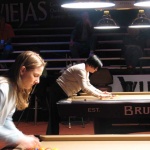
Ready, set, rack! WPBA President Kim White of Texas and Val Finnie of Scotland rack in the first round.
Defending champion Kelly Fisher won her first match over California’s Darlene Stinson, 9-1, and looks well poised to make her way to the finals. Local favorite Tina Pawlowski suffered her first loss at the hand’s of Virginia’s Sueyen Rhee, but will return today to compete against Wisconsin’s Jeri Engh.
First round upsets included #51-ranked Lisa D’Atri over Colorado’s #24-ranked Laura Smith; #42-ranked semi-pro Leslie Anne Rogers of Texas over #26-ranked pro Melissa Little; newcomer Julia Gabriel over #31-ranked Stacy Hurst of Southern California; and the Florida Flash, #43-ranked Ellen Van Buren over #19-ranked Romana Dokovic.
Big matches in the winner’s bracket will take place tonight, including Jeanette Lee vs. Kelly Fisher and Kim Shaw vs. Dawn Hopkins, who dismissed both Tiffany Nelson, 9-5, and Kim White, 9-7, in preliminary rounds.
Stay tuned for more coverage here at HeadString, or follow updated tournament brackets and highlights at www.wpba.com.
WPBA San Diego Classic Underway
First-round matches are underway today, April 20, at the 2006 WPBA San Diego Classic, at Viejas Casino in Alpine, Calif.
Kelly Fisher won her first U.S. title at this tournament last year, when she defeated Gerda Hofstatter in the final match. Both players have returned this year and, providing they both win their first three respective matches, are destined to meet again in the fourth round, scheduled for 9:30 p.m. Saturday, April 22.
Stay tuned to HeadString News for highlights, or watch for ongoing results at www.wpba.com.

